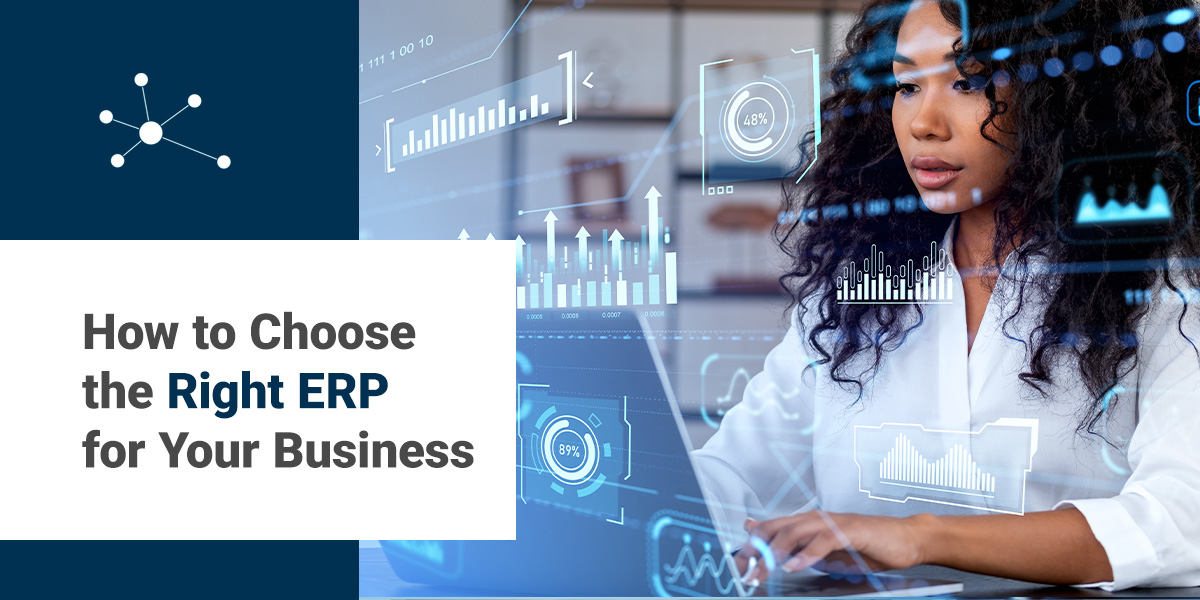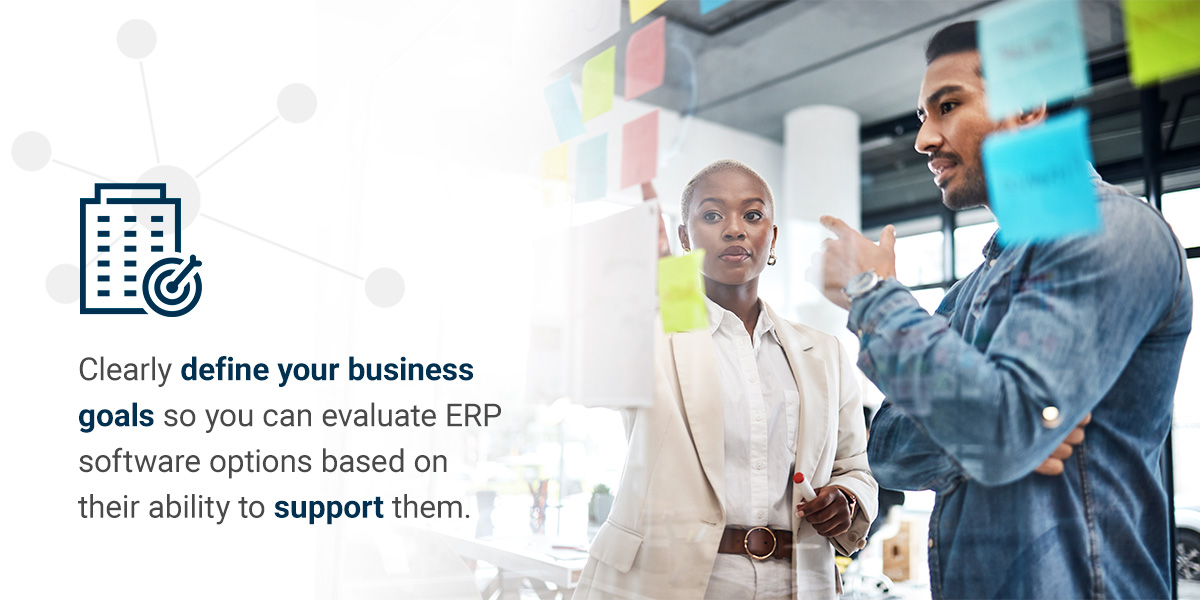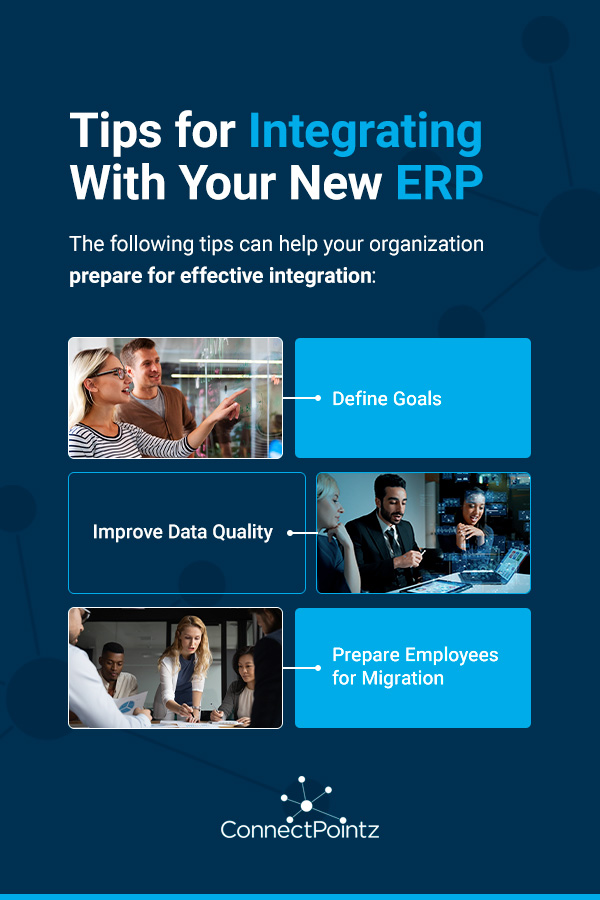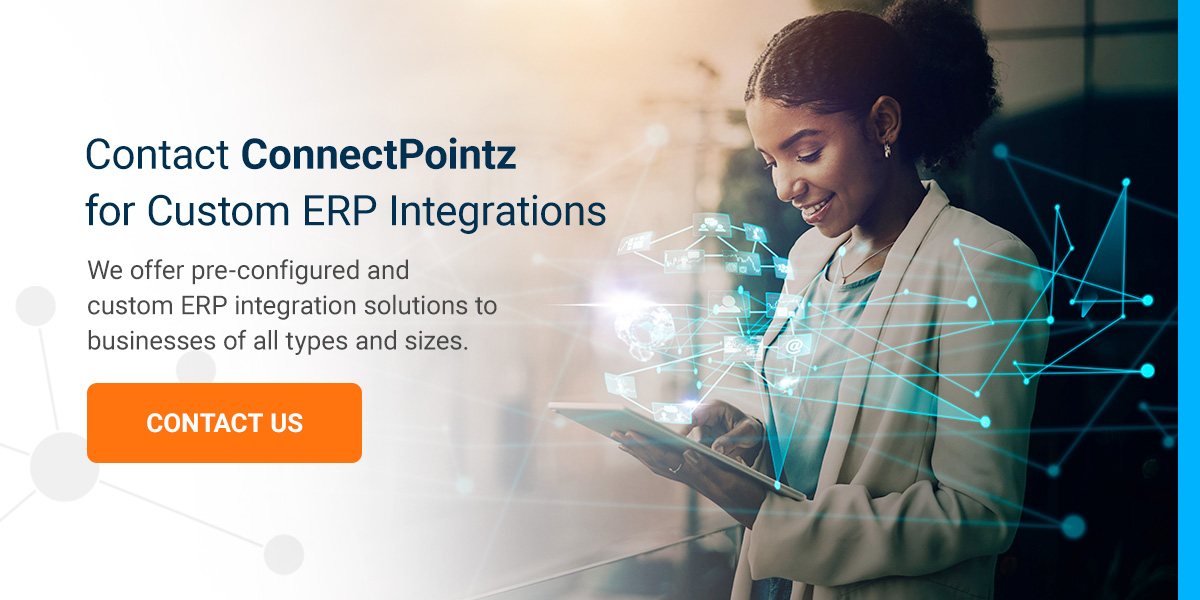
An enterprise resource planning (ERP) system is an integrated applications suite that streamlines critical business functions to save time and money. ERP systems offer varying benefits for companies of different sizes and industries, so knowing how to choose an ERP system that works best for your organization enables you to maximize your investment.
Why Selecting the Right ERP Is Critical
With the right ERP powering your organization, you can unify processes and applications across business use cases for improved collaboration and efficiency. An ERP provides automation and access to reliable data, enabling you to enhance decision-making processes and workflows. These systems can serve as a convenient and reliable single source of accurate information. With centralized data, you can improve security and regulatory compliance.
Selecting an ERP system that suits your unique business requirements empowers your organization's growth. This system can support your current needs while offering scalability. The right ERP also allows you to remain competitive by driving savings and capitalizing on business opportunities.
Overall, choosing an ERP system is an important decision that requires dedicated time and resources to ensure a significant return on your investment.
6 Steps for Choosing an ERP
Careful consideration in your search for an ERP will enable you to find the system that works for your requirements, budget and goals. As you adhere to these ERP evaluation criteria, you can identify the ERP software options that address your current and future business objectives:
1. Audit Existing Applications and Workflows
To choose the right ERP for your organization, you must first evaluate your current applications and operations. Knowing where you stand can reveal where an ERP can improve business processes for greater efficiency and cost savings.
Conduct audits to gain a holistic view of your operations and any silos, security issues or legacy tools that may be causing bottlenecks in your workflows. As you review processes in each department throughout your organization, think about areas where an ERP can help streamline tasks. Document what changes you will need to make to migrate to a new ERP.
2. Determine Your ERP Requirements

After auditing workflows and applications, you should have an idea of what you need from an ERP to ensure your operations run smoothly. Clearly define your business goals so you can evaluate ERP software options based on their ability to support them.
You can organize your ERP requirements into three categories:
- Mandatory: These tasks are required to perform job functions or meet industry regulations. Prioritize these requirements when determining which ERP software to get.
- Value-add: While these tasks are not required to complete essential duties, they are still valuable. Many value-added functions can streamline manual functions to improve efficiency and accuracy.
- Nice to have: Features that offer convenience are the last ones to consider when looking at ERP options. If multiple ERP systems have the mandatory and value-added functionalities you want, you may look for ease-of-use features that will continue to improve workflows.
3. Decide Between Cloud vs. On-Premise
Choosing an on-premise ERP system, a cloud ERP system or a hybrid solution will depend on your organization's unique financial standing, compliance requirements and business needs. These different ERP deployments offer varying benefits and considerations, including:
- Mobile accessibility: To improve mobility, on-premise ERP systems need remote access setup. Users can easily access a cloud ERP system from anywhere and from any device as long as they have an internet connection.
- Total cost of ownership: On-premise ERP systems require a substantial upfront investment and ongoing maintenance expenses, but they may be more cost-effective over time, depending on your organization. Cloud ERP systems require a subscription, which minimizes upfront and maintenance costs.
- Control: An on-premise system gives you full control over your data infrastructure, system configurations, maintenance schedules and upgrades. With a cloud ERP, the vendor manages these aspects, which means you get automatic updates but fewer customization opportunities.
- Security and privacy: If you have an on-premise ERP, security and privacy are entirely your responsibility. If you choose a cloud ERP system, you rely on the vendor's security measures and privacy protection procedures.
- Scalability: To scale an on-premise system to meet growth needs, you will need the physical space and additional hardware to expand. Cloud ERP systems simplify scalability for some organizations.
- Deployment speed: On-premise ERPs can take significant time to fully deploy and customize to business needs. A cloud ERP can be ready much more quickly, but customization options are fewer.
4. Create a Team to Research and Select an ERP
Your new ERP system will affect your entire organization — employees should have a say in which ERP system you select. Develop a team with stakeholders from each department that will be affected by the new ERP software. These stakeholders can provide insights into their department's workflow and which ERP option will help rather than hinder.
You may want representatives from departments such as:
- Customer service
- Information technology
- Finance
- Manufacturing
- Sales and marketing
- Supply chain
It's also beneficial to consult with an expert in ERP implementation. An ERP professional has extensive experience working with a variety of ERP systems, so they understand their strengths and weaknesses. They can offer a vendor-neutral perspective that helps you choose an ERP that suits your industry and business requirements.
5. Evaluate Vendor Experience and Reputation
As your ERP research and selection team reviews the available options, they should consider each vendor's reputation and experience within your industry. Check for references from organizations similar to yours in size, industry, culture and requirements. These testimonials can help you validate vendor claims and find a vendor that understands the nuances of your industry and business.
Other points to evaluate include:
- Reviews about the vendor's customer service: Learn if you can count on the vendor's assistance and availability.
- How often the ERP system is updated: Continual updates show a vendor is committed to improving their product.
- Dedication to innovation: You need a vendor that avoids buzzwords and delivers on the innovation and quality they promise.
6. Consider Costs and Scalability
While the base cost of ERP software is important to consider, you will also need to account for other associated costs with purchasing an ERP system. These expenses could include:
- Implementation
- Data migration
- On-premise hardware
- Additional modules or customizations
- Maintenance and ongoing support
- Training
As you document potential costs, be sure to factor in scalability. You will want an ERP system that can grow with your business, which may translate to higher costs in the future. Look at pricing models to determine what adding users and growing your operations will cost.
Common ERP Features
ERP systems connect nearly every core business function in your organization. As you review different ERP options, you will find that most offer similar convenient features that simplify workflows, improve data accuracy and enhance operations unique to your business.
System Integration
Integration enables you to access data from multiple sources for easier decision-making and greater efficiency. Many ERP systems integrate with other applications — the question to consider is how easily they integrate. When choosing an ERP solution, evaluate its ability to provide a comprehensive view of your business, operational and financial data.
Data Management
Most ERP systems offer ways to manage your data to improve accuracy and visibility. With real-time information, you can make timely adjustments that streamline operations and improve growth. Some common data management features include:
- Data collection and real-time tracking
- Analysis
- Reporting and visualization
- Storage
Automation

ERP software automates manual repeatable tasks across departments, from accounting to human resources. Every part of your organization will benefit from improved efficiency and accuracy, along with more time to focus on essential, value-added tasks and growth opportunities. Automation can enhance workflow management and collaboration, leading to more revenue and satisfied customers.
Compliance Support
Many ERP systems make regulatory compliance simpler and easier for your organization. They can assist with data security, automated reporting, quality control, audit trails, and other aspects necessary for proving compliance with your industry's specific regulations.
While an ERP can't outline which regulations your business needs to follow, it does allow you to embed your own compliance framework into automated workflows to minimize errors and ensure more compliant processes.
Modules
Every ERP system offers a range of modules to simplify workflows across departments. To choose an ERP software for your organization, look for modules that will most benefit your business. ERP systems typically offer modules such as:
- Finance management: ERP software can offer core financial and accounting systems to streamline financial duties and ensure compliance. ERP systems can help with a variety of needs, including financial reporting, accounts receivable and payable, billing, and budgeting.
- Supply chain management: Optimize and automate your supply chain processes for smoother, quicker operations. ERP software can organize supply chain steps such as forecasting, shipping, logistics and warranty management.
- Resource and inventory management: With the right ERP system, you can ensure you have the resources and inventory needed to meet demands. This module can assist with e-commerce needs such as customer orders and returns.
- Customer relationship management (CRM): If you need to track and manage communication and contact with your customers, you may need a CRM module in your ERP system. A CRM module can help coordinate, automate and manage various aspects of the customer journey, helping to improve satisfaction and efficiency.
- Sales and marketing management: This module can help boost sales and increase your bottom line. It can make selling and marketing your products and services easier by assisting with forecasting, lead generation, campaign management, and customer activity tracking.
- Human resources (HR) management: An ERP system can streamline various HR tasks, such as payroll and taxes, onboarding, time off requests, and productivity tracking. An HR management module enables managers and HR staff to handle employee data and other HR information efficiently and accurately.
- Manufacturing management: Gain end-to-end visibility into your manufacturing processes with the right module. A manufacturing module can help you manage and analyze production control, warehouse operations, distribution scheduling, and other critical processes.
Tips for Integrating With Your New ERP

After assessing your business needs, reviewing ERP options and selecting the ERP system most suitable for your organization, you'll need to prepare for implementation. Adequate preparation promotes a successful ERP integration that seamlessly transitions processes, streamlines workflows and equips employees with the tools they need to learn and succeed.
The following tips can help your organization prepare for effective integration:
Define Goals
Starting with a clear idea of your implementation outcomes empowers you to reach them more efficiently. First, assess your current business processes and identify potential pain points that may arise as you begin migrating to your new ERP system. Set goals that enable your team members to ease those pain points and streamline the migration process.
While setting goals, remember to generate a realistic timeline. ERP implementation can be complex, depending on your organization's size. Being realistic about how long implementation will take can help you plan for employee learning curves and manage expectations.
Improve Data Quality
When your organization makes a major systems shift to a new ERP, you want to be sure your data is ready to move. Data transfer errors or inefficiencies can cause problems as you try to get your new system up and running, so it's best to improve data quality before implementation.
Focus on data quality by:
- Assessing current data quality: The first step to improving data quality is to know where you stand. Evaluate data throughout your organization and prioritize areas that need attention before ERP integration.
- Creating a data management strategy: Assign data ownership before migration and ensure each team member knows their responsibilities throughout implementation. Outline clear procedures to improve and protect data quality as you migrate.
- Investing in data cleansing: Before ERP migration, invest the time and tools necessary to improve data accuracy and relevance. If you know your data is clean, you can trust it after implementing your new ERP system.
Prepare Employees for Migration
In addition to improving data quality, you'll need to get ready for ERP migration by preparing your employees for the change. Document which changes will occur throughout your organization and how they'll affect your workforce. Assess questions such as:
- How much training will employees need to understand and use the new ERP system?
- What will employees experience during the implementation process?
- Do team members understand the significance of this ERP implementation?
Contact ConnectPointz for Custom ERP Integrations
Once you've found the right ERP system for your organization, you will need to navigate the complex integration process carefully to ensure successful implementation. ConnectPointz can help. We offer pre-configured and custom ERP integration solutions to businesses of all types and sizes, enabling you to seamlessly integrate your new ERP system with your current business systems and platforms.
Our solutions empower your businesses to connect, integrate and automate backend processes to reduce errors, enhance efficiency and generate larger overall profit margins. Contact us today to see how our solutions can help with ERP implementation.










































